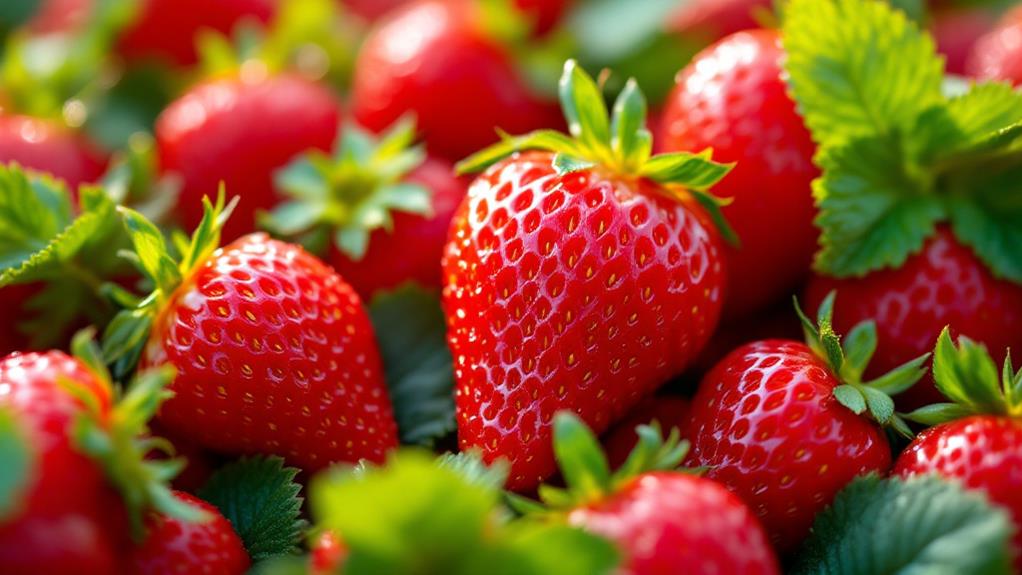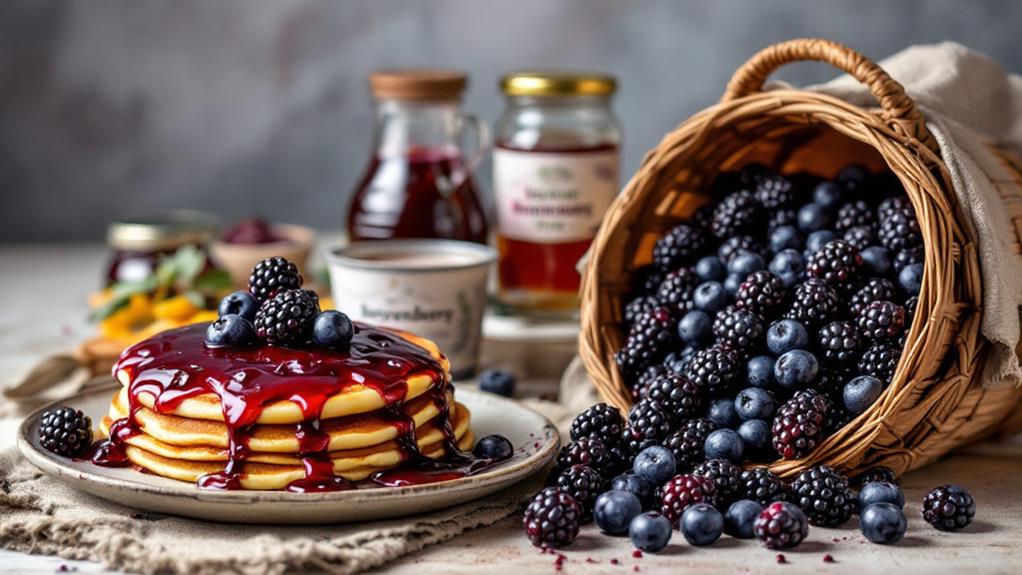June-Bearing Strawberries: A Guide to Growing and Enjoying These Summer Treats
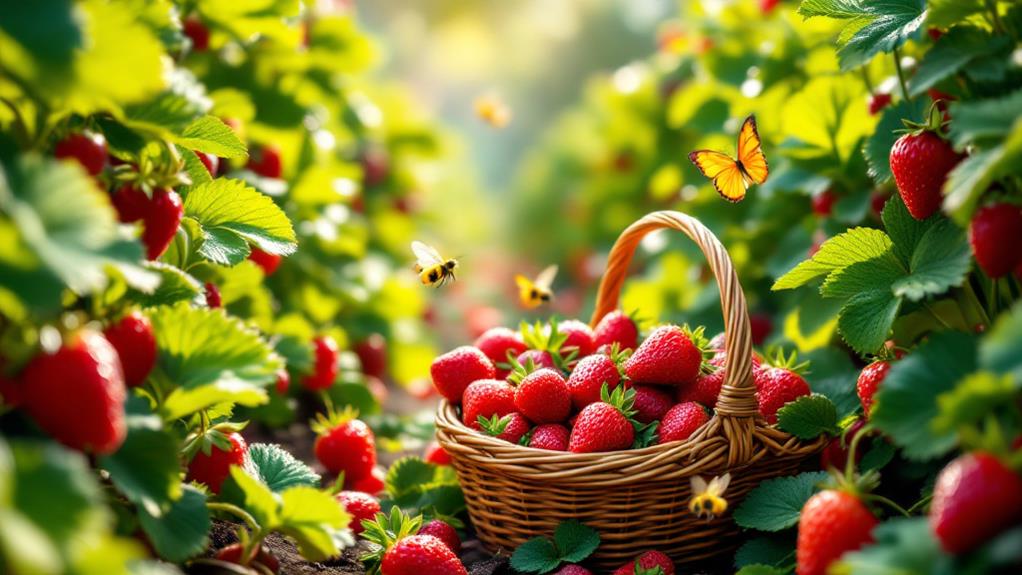
June-bearing strawberries are a delightful enhancement to your garden, offering a robust harvest in June, perfect for desserts and jams. Choose popular varieties like Earliglow or Jewel for sweet-tangy flavor and strong disease resistance. Plant your strawberries in a sunny spot with well-draining, slightly acidic soil enriched with organic matter. Regular watering and mulching will help maintain healthy plants. Protect your crop from pests with natural deterrents and guarantee a steady harvesting schedule to enjoy the essence of summer. For more on selecting varieties, planting tips, and maximizing your enjoyment, there's plenty more to uncover.
Benefits of June-Bearing Strawberries
June-bearing strawberries offer several compelling benefits that make them a favorite among gardeners and strawberry enthusiasts. When you grow these strawberries, you're rewarded with one large, concentrated harvest in June. This abundance is perfect for making fresh jams, mouthwatering desserts, or freezing them for year-round enjoyment. These strawberries, known for their impressive size and flavor, include popular varieties like Earliglow, Jewel, and Honeoye. Their sweet and tangy taste profiles make them highly sought after, adding a delightful burst of flavor to your culinary creations.
One of the most appealing aspects of June-bearing strawberries is their vigor and disease resistance. You'll find them easier to cultivate compared to other types, making them ideal for home gardeners seeking a successful harvest. Plus, when you grow your own June-bearing strawberries, they're fresher and more nutritious than store-bought options. Harvesting them at peak ripeness guarantees they deliver higher levels of vitamin C and antioxidants, enhancing both taste and health benefits.
Ultimately, cultivating June-bearing strawberries not only provides a bountiful supply of fresh, nutritious fruit but also enriches your gardening experience with their robust growth and exceptional flavor.
Selecting the Right Varieties
When selecting the right varieties of June-bearing strawberries, it's vital to evaluate factors like flavor, size, and growth characteristics to improve your harvest. You'll want to start by considering what matters most to you. If flavor tops your list, Earliglow strawberries are a fantastic choice. They're known for their small to medium size and sweet, tangy flavor, making them a favorite for fresh eating and desserts.
For those who prioritize size and productivity, Jewel strawberries might be the ideal pick. These strawberries produce large, glossy red fruits with excellent taste, offering a high yield that's satisfying to harvest. Jewel is popular among gardeners who want to make the most of their June crop.
If disease resistance is a significant factor for you, consider Allstar strawberries. These mid-June bearers produce large, firm berries and stand out for their ability to resist common strawberry diseases, ensuring a healthy and bountiful harvest.
Each variety of June-bearing strawberries has its unique benefits. By selecting the right variety based on your specific needs—whether it's flavor, size, or resilience—you'll enjoy a successful and rewarding strawberry season.
Preparing the Planting Site
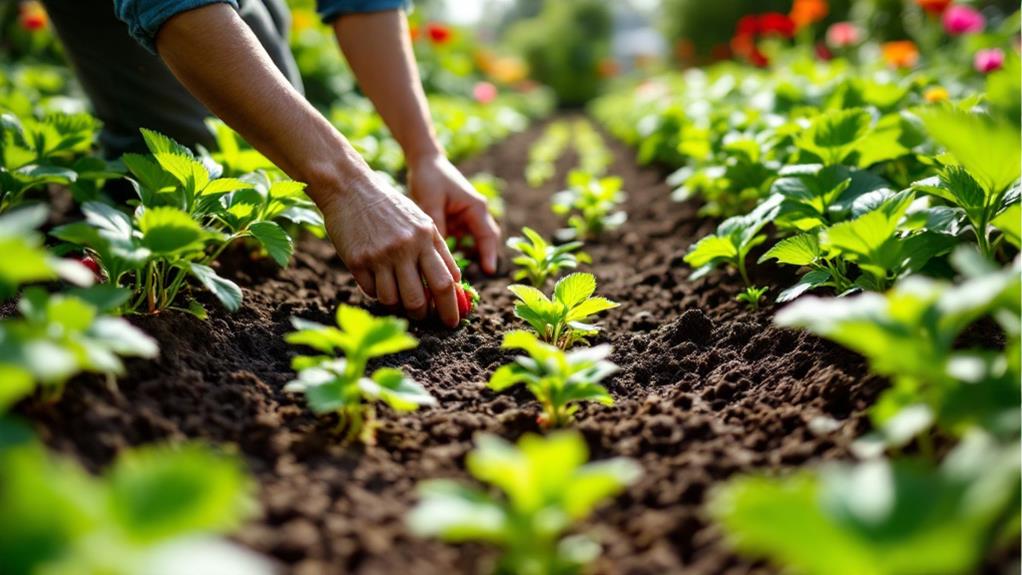
To guarantee your strawberries thrive, start by selecting an ideal location that receives plentiful sunlight—at least six hours of direct sun each day is perfect. Your strawberry plants need full sun to produce the most abundant and sweetest fruit. Once you've chosen the right spot, focus on preparing the soil. Your goal is to create a loose, well-draining environment that's rich in organic matter. This involves loosening the soil to a depth of 12 inches, confirming it's free from weeds and large rocks.
Next, check the soil's acidity. Aim for a slightly acidic pH between 5.5 and 6.8, as this range is best for strawberry plants. To improve the soil's fertility and moisture retention, incorporate compost or well-rotted manure into the mix. This not only enriches the nutrient content but also helps maintain necessary moisture levels.
When it comes to spacing your June-bearing strawberry plants, plant them 15-30 inches apart in rows that are 36 inches apart. This spacing guarantees adequate air circulation and provides room for runner development, promoting healthy growth. By following these steps, you'll create the perfect planting site for your strawberries to flourish.
Optimal Planting Techniques
After preparing the perfect planting site, it's time to focus on the ideal techniques for planting your strawberries. For June-bearing strawberries, you'll want to plant them in early spring, about 3-4 weeks before the last frost. Confirm the soil is well-draining and slightly acidic with a pH between 5.5 and 6.5 for optimal growth. Space the plants 12-18 inches apart in matted rows, giving them room to develop up to six runners.
When you plant, verify the crown of each strawberry plant is level with or slightly above the soil surface. This prevents rot and encourages healthy growth. Pinching off all flowers during the planting year is crucial; this redirects the plant's energy into establishing a strong crown, leaf, and root system. After planting, mulching with straw or compost helps retain soil moisture, suppress weeds, and maintain stable temperatures.
Consider these key points for successful planting:
- Plant 3-4 weeks before the last frost.
- Verify crowns are level with the soil surface.
- Space plants 12-18 inches apart.
- Mulch to retain moisture and suppress weeds.
Following these techniques will set your June-bearing strawberries on the path to thriving.
Essential Care and Maintenance
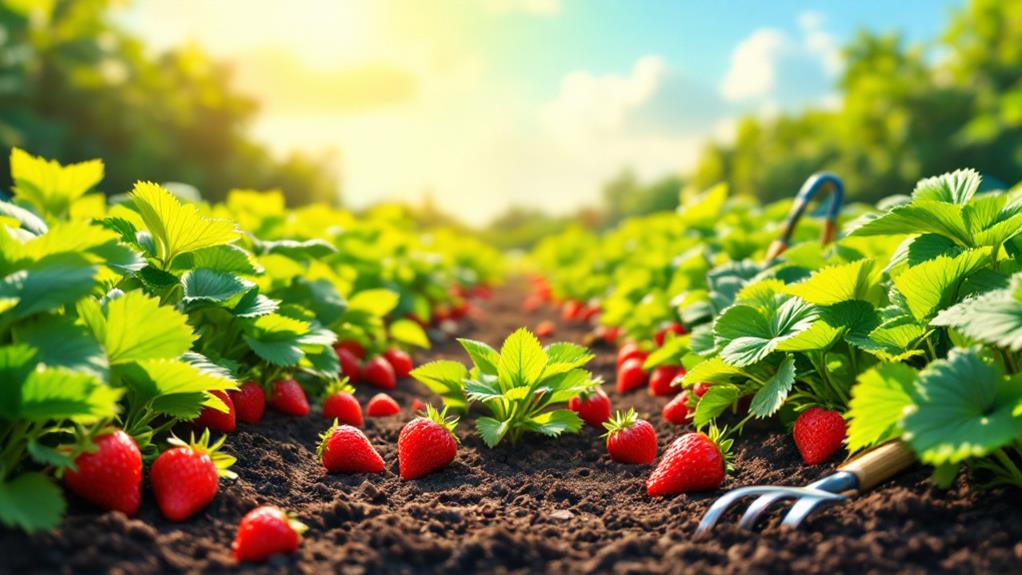
Caring for your June-bearing strawberries is fundamental for a bountiful harvest. Regular watering is key; aim for 1-2 inches of water weekly, ensuring consistent moisture, especially during dry spells. This helps maintain healthy growth, leading to more robust plants and better fruit production. Mulching with straw or compost is another important step. It not only retains moisture but also suppresses weeds, reducing competition for critical nutrients. Healthier plants produce more fruit, so don't skip this step.
Fertilization plays a significant role in the plant's lifecycle. After the harvest, apply a low nitrogen/high phosphorus fertilizer. This encourages strong root development and sets the stage for next season's fruit production. Remember, strong roots support healthy growth and larger yields.
In the initial planting year, pinch off early blooms. This practice redirects energy to develop stronger crowns, leaves, and roots, which translates into better yields in future years. Regular monitoring for pests and diseases is also necessary for maintaining plant health, but that's another topic. By focusing on these fundamental care and maintenance steps, you'll enjoy a delicious and plentiful strawberry harvest each summer.
Effective Pest Management
In the domain of strawberry cultivation, dealing with pests is an inevitable challenge. Effective pest management is essential for guaranteeing your plants thrive and produce delicious fruit. Regularly monitor your strawberry plants as this helps you spot early signs of trouble, reducing the risk of infestations by slugs and aphids. Slugs can wreak havoc on your strawberries, but a simple remedy involves using crushed eggshells. Sprinkle them on the soil's surface to create an unfriendly environment for these slimy intruders.
To protect your strawberries from birds, which often consume the fruit before it ripens, consider using netting. This simple barrier keeps your harvest safe while allowing sunlight and rain to reach your plants. Organic insecticides are another tool in your pest management arsenal, especially useful against aphids and spider mites. They guarantee minimal impact on the environment and preserve beneficial insects.
Fungal diseases pose another threat, often exacerbated by high humidity and overcrowding. Implement proper spacing and guarantee good air circulation around your plants to keep these issues at bay. Consider these strategies:
- Regularly monitor for pests
- Use crushed eggshells for slugs
- Protect with netting
- Employ organic insecticides
Harvesting Best Practices
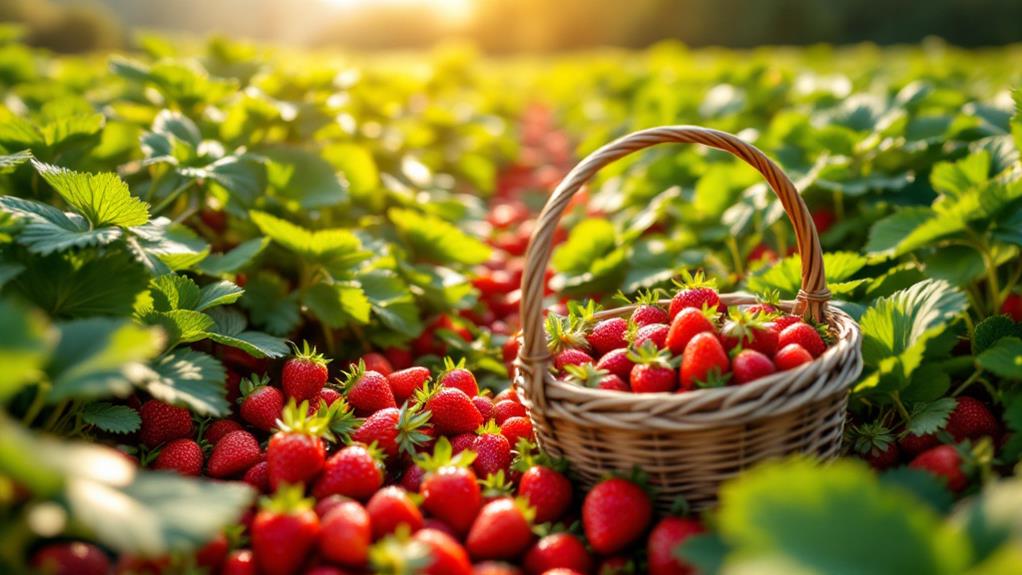
In relation to harvesting June-bearing strawberries, timing and technique are key to maximizing flavor and yield. For the best flavor, make certain to pick the strawberries only when they're fully red and firm, with no hints of green or white. This guarantees you're getting the best quality. Early morning is the ideal time for harvesting since the cooler temperatures help preserve the strawberries' flavor and texture. By picking them in the morning, you maintain the freshness that makes homegrown strawberries so delightful.
When you're ready to harvest, gently twist each strawberry to detach it from the plant. Leave about a quarter of an inch of the stem attached. This method minimizes damage to both the fruit and the plant, allowing for a healthier yield and better-tasting strawberries. During the peak season, aim to harvest every 2-3 days. This consistent schedule not only increases your total yield but also confirms that each berry is enjoyed at its freshest.
Enjoying Your Strawberry Harvest
A basket full of freshly harvested June-bearing strawberries offers endless culinary possibilities. You're in for a treat, as these berries are perfect for a variety of culinary creations. When you pluck them at peak ripeness—fully red and firm—you'll experience the best of their flavor. To truly savor your harvest, consider these delicious options:
- Strawberry Shortcake: Layer juicy strawberries with whipped cream for a classic dessert.
- Homemade Jam: Capture the essence of summer by simmering strawberries into a sweet spread.
- Strawberry Pies: Bake them into a pie that bursts with flavor in every bite.
- Revitalizing Smoothies: Blend them into a smoothie for a rejuvenating, nutritious drink.
Proper storage is key to enjoying your strawberries longer. Keep them in the refrigerator, where they'll stay fresh for 3 to 7 days. Remember to rinse them gently right before use to maintain their quality. If your harvest is more than you can enjoy fresh, freezing is a fantastic option. This preserves both flavor and nutrients, meaning you can enjoy these summer treats even in the off-season. By thinking creatively and storing them properly, you'll enhance the enjoyment of your strawberry harvest.

